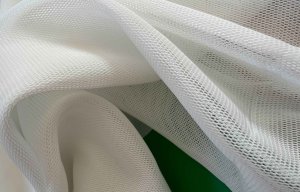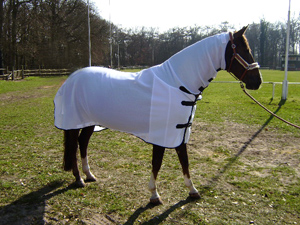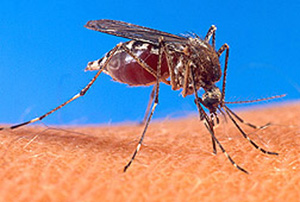
Permanent performance with new Baltex spacer
Researchers have developed an Insect protection blanket which prevents horses being bitten by insects which could be harmful to their health. The blanket is made from a lightweight spacer fabric incorporating a replaceable repellent and is said to possess good moisture vapour transmission to eliminate sweat evaporation problems. The project took place at the Institute for Hygiene and Biotechnology at the Hohenstein Institutes in Bönnigheim, Germany and the work was carr

3rd May 2011
Innovation in Textiles
|
Boennigheim
 Researchers have developed an Insect protection blanket which prevents horses being bitten by insects which could be harmful to their health. The blanket is made from a lightweight spacer fabric incorporating a replaceable repellent and is said to possess good moisture vapour transmission to eliminate sweat evaporation problems.
Researchers have developed an Insect protection blanket which prevents horses being bitten by insects which could be harmful to their health. The blanket is made from a lightweight spacer fabric incorporating a replaceable repellent and is said to possess good moisture vapour transmission to eliminate sweat evaporation problems.
The project took place at the Institute for Hygiene and Biotechnology at the Hohenstein Institutes in Bönnigheim, Germany and the work was carried out under the direction of Dr. Timo Hammer in conjunction with HKM Sports Equipment GmbH, Neuenhaus, as part of a joint research project (ZIM KF 2136703SB9) into functional protection for the animals.
“Horse owners will be familiar with the problem - every year in summer, the animals are swarmed by mosquitoes and horseflies,” explains Dr Hammer.
“For some animals the insects pose a real threat, as they have an allergic reaction to insect bites and contract serious health problems such as the dreaded sweet itch,” Dr Hammer adds.
“Up until now, horses needed to be sprayed daily with insect repellents to protect them from insects, which in the long term proves expensive and often even harmful to their health,” he clarifies.
Dr Hammer says that in general, there are two options for protecting animals and humans from insect bites. The first is by applying substances to deter insects, known as repellents. The second is mechanical protection where the mosquito lands on its victim, but is prevented from biting by a fabric.
 The aim of the project was to develop a blanket which would offer maximum security by combining principles, mechanical and chemical and the fabric should be as resistant to puncturing by as many different types of insects as possible, from tiny mosquitoes to large horseflies.
The aim of the project was to develop a blanket which would offer maximum security by combining principles, mechanical and chemical and the fabric should be as resistant to puncturing by as many different types of insects as possible, from tiny mosquitoes to large horseflies.
To test this, the Hohenstein researchers developed a test system to check the resistance of fabrics to puncturing by insects and in the test, the biting and piercing apparatus of central European pests are simulated. As well as providing a mechanical protective effect, the blanket was also to be comfortable for the horse to wear and the repellent needed to be skin-friendly. Another requirement of the fabric was that the animals did not sweat under it and that no toxicological substances were absorbed through licking the insect protection blanket.
The result of the research project is said to be a blanket which protects the horse extensively using an extremely light spacer fabric with optimised fit and which is also pleasant to wear.
“The light weight fabric used for the blanket means that the animals don't suffer any build up of heat, even in the height of summer. The textile also has good moisture vapour transmission which means that sweat evaporating from the animal causes no problem,” Dr Hammer explains.
Dr Hammer says that when incorporating the repellent, a practical and at the same time gentle solution was found. The protective blanket can be equipped with replaceable delivery systems for the active substances.
“This means that the animal is protected against insects by natural active substances for several weeks,” Dr Hammer says. The delivery system for synthetic substances is said to be easily replaced, thus avoiding excessive use of chemicals. The blanket is also said to be wash-resistant and weatherproof, making it suitable for long-term use.
"The innovative horse protection blanket is a successful example of the rapid development of a good idea into a marketable product," says Dr Hammer. The new horse protection blanket will be available in the shops as of summer 2012.
The project ZIM KF 2136703SB9 was funded by the Federal Ministry of Economics and Technology (BMWi) based on a decision by the German parliament. Construction and production details for the spacer fabric are not being made available at present for reasons of confidentiality.

Business intelligence for the fibre, textiles and apparel industries: technologies, innovations, markets, investments, trade policy, sourcing, strategy...
Find out more